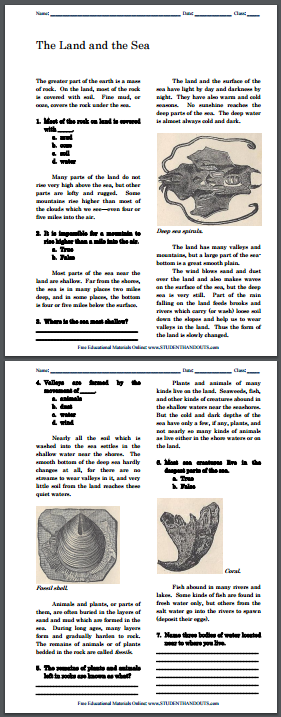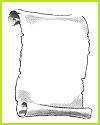| The Land and the Sea Reading with Questions |
|---|
| www.studenthandouts.com ↣ World Geography ↣ Geography Worksheets |
The greater part of the earth is a mass of rock. On the land, most of the rock is covered with soil. Fine mud, or ooze, covers the rock under the sea.
 1. Most of the rock on land is covered with _____.
1. Most of the rock on land is covered with _____. a. mud b. ooze c. soil d. water Many parts of the land do not rise very high above the sea, but other parts are lofty and rugged. Some mountains rise higher than most of the clouds which we see—even four or five miles into the air. 2. It is impossible for a mountain to rise higher than a mile into the air. a. True b. False Most parts of the sea near the land are shallow. Far from the shores, the sea is in many places two miles deep, and in some places, the bottom is four or five miles below the surface. 3. Where is the sea most shallow? The land and the surface of the sea have light by day and darkness by night. They have also warm and cold seasons. No sunshine reaches the deep parts of the sea. The deep water is almost always cold and dark. The land has many valleys and mountains, but a large part of the sea-bottom is a great smooth plain. The wind blows sand and dust over the land and also makes waves on the surface of the sea, but the deep sea is very still. Part of the rain falling on the land feeds brooks and rivers which carry (or wash) loose soil down the slopes and help us to wear valleys in the land. Thus the form of the land is slowly changed. 4. Valleys are formed by the movement of _____. a. animals b. dust c. water d. wind Nearly all the soil which is washed into the sea settles in the shallow water near the shores. The smooth bottom of the deep sea hardly changes at all, for there are no streams to wear valleys in it, and very little soil from the land reaches these quiet waters. Animals and plants, or parts of them, are often buried in the layers of sand and mud which are formed in the sea. During long ages, many layers form and gradually harden to rock. The remains of animals or of plants bedded in the rock are called fossils. 5. The remains of plants and animals left in rocks are known as what? Plants and animals of many kinds live on the land. Seaweeds, fish, and other kinds of creatures abound in the shallow waters near the seashores. But the cold and dark depths of the sea have only a few, if any, plants, and not nearly so many kinds of animals as live either in the shore waters or on the land. 6. Most sea creatures live in the deepest parts of the sea. a. True b. False Fish abound in many rivers and lakes. Some kinds of fish are found in fresh water only, but others from the salt water go into the rivers to spawn (deposit their eggs). 7. Name three bodies of water located near to where you live. Click here to print this worksheet (PDF). Click here for more Geography worksheets. Answer Key: (1) C - soil; (2) B - False; (3) Near the shore; (4) C - water; (5) Fossils; (6) B - False; (7) Answers will vary. |
 |  |  |  |  |  |
| www.studenthandouts.com ↣ World Geography ↣ Geography Worksheets |








